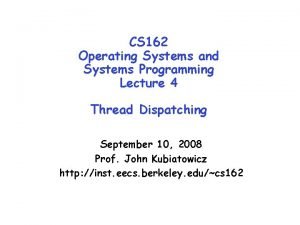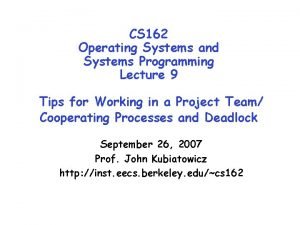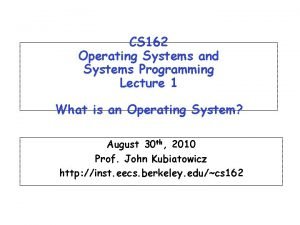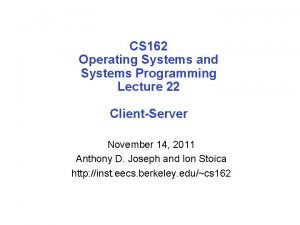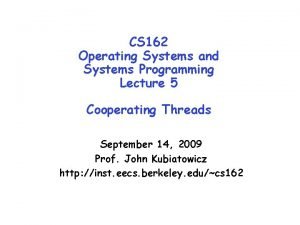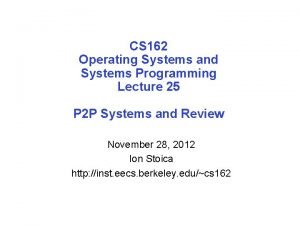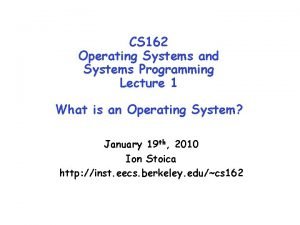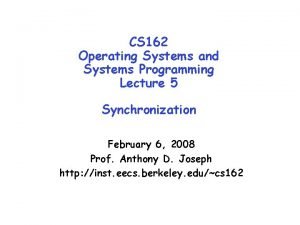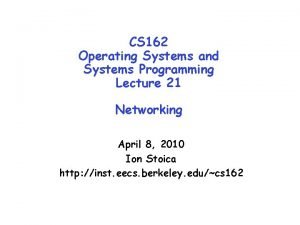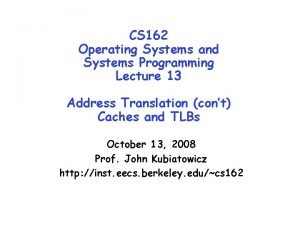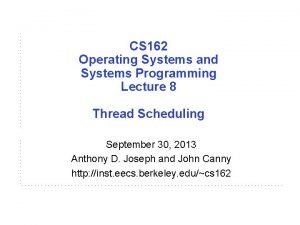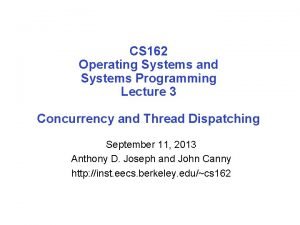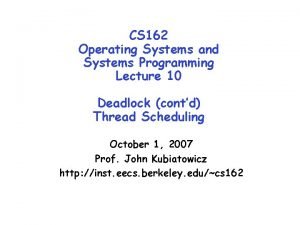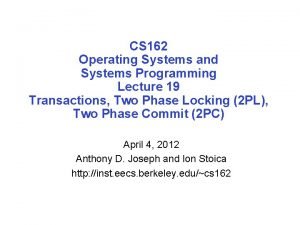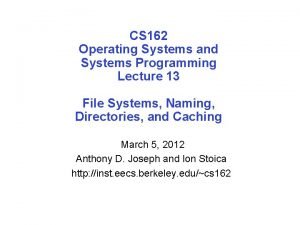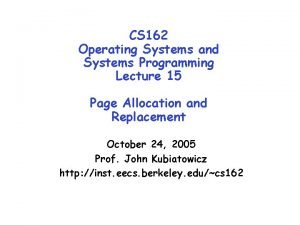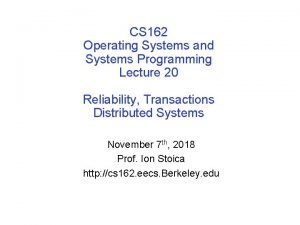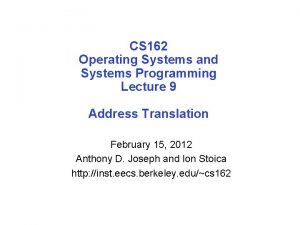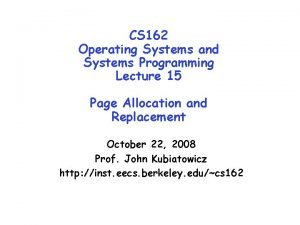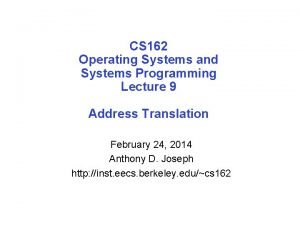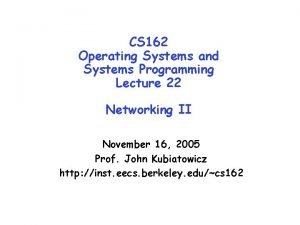CS 162 Operating Systems and Systems Programming Lecture
















![Examples of Read-Modify-Write • test&set (&address) { /* most architectures */ result = M[address]; Examples of Read-Modify-Write • test&set (&address) { /* most architectures */ result = M[address];](https://slidetodoc.com/presentation_image_h/b62485e3a45ed71f27f6d9fa365bfe3d/image-17.jpg)















- Slides: 32

CS 162 Operating Systems and Systems Programming Lecture 7 Mutual Exclusion, Semaphores, Monitors, and Condition Variables September 21, 2005 Prof. John Kubiatowicz http: //inst. eecs. berkeley. edu/~cs 162

Review: A Concurrent Program Example • Two threads, A and B, compete with each other – One tries to increment a shared counter – The other tries to decrement the counter Thread A Thread B i = 0; while (i < 10) while (i > -10) i = i + 1; i = i – 1; printf(“A wins!”); printf(“B wins!”); • Assume that memory loads and stores are atomic, but incrementing and decrementing are not atomic • Who wins? Could be either • Is it guaranteed that someone wins? Why or why not? • What it both threads have their own CPU running at same speed? Is it guaranteed that it goes on forever? 9/21/05 Kubiatowicz CS 162 ©UCB Fall 2005 Lec 7. 2

Review: Hand Simulating Multiprocessor Example • Inner loop looks like this: r 1=0 load r 1=1 add M[i]=1 Thread A Thread B r 1, M[i] r 1=0 load r 1, M[i] r 1, 1 r 1=-1 sub r 1, 1 store r 1, M[i]=-1 store r 1, M[i] • Hand Simulation: – – – And we’re off. A gets off to an early start B says “hmph, better go fast” and tries really hard A goes ahead and writes “ 1” B goes and writes “-1” A says “HUH? ? ? I could have sworn I put a 1 there” • Could this happen on a uniprocessor? – Yes! Unlikely, but if you depending on it not happening, system CS 162 will break… 9/21/05 it will and your Kubiatowicz ©UCB Fall 2005 Lec 7. 3

Review: Too Much Milk Solution #3 • Here is a possible two-note solution: Thread A Thread B leave note A; leave note B; while (note B) { if (no. Note A) { do nothing; if (no. Milk) { } buy milk; } } remove note B; remove note A; • Does this work? Yes. Both can guarantee that: – It is safe to buy, or – Other will buy, ok to quit • At A: – if no note B, safe for A to buy, – otherwise wait to find out what will happen • At B: – if no note A, safe for B to buy – Otherwise, A is either buying or waiting for B to quit 9/21/05 Kubiatowicz CS 162 ©UCB Fall 2005 Lec 7. 4

Goals for Today • Hardware Support for Synchronization • Higher-level Synchronization Abstractions – Semaphores, monitors, and condition variables • Programming paradigms for concurrent programs Note: Some slides and/or pictures in the following are adapted from slides © 2005 Silberschatz, Galvin, and Gagne 9/21/05 Kubiatowicz CS 162 ©UCB Fall 2005 Lec 7. 5

High-Level Picture • The abstraction of threads is good: – Maintains sequential execution model – Allows simple parallelism to overlap I/O and computation • Unfortunately, still too complicated to access state shared between threads – Consider “too much milk” example – Implementing a concurrent program with only loads and stores would be tricky and error-prone • Today, we’ll implement higher-level operations on top of atomic operations provided by hardware – Develop a “synchronization toolbox” – Explore some common programming paradigms 9/21/05 Kubiatowicz CS 162 ©UCB Fall 2005 Lec 7. 6

Where are we going with synchronization? Programs Shared Programs Higherlevel API Locks Hardware Load/Store Semaphores Monitors Disable Ints Send/Receive Test&Set Comp&Swap • We are going to implement various higher-level synchronization primitives using atomic operations – Everything is pretty painful if only atomic primitives are load and store – Need to provide primitives useful at user-level 9/21/05 Kubiatowicz CS 162 ©UCB Fall 2005 Lec 7. 7

How to implement Locks? • Lock: prevents someone from doing something – Lock before entering critical section and before accessing shared data – Unlock when leaving, after accessing shared data – Wait if locked » Important idea: all synchronization involves waiting • Atomic Load/Store: get solution like Milk #3 – Looked at this last lecture – Pretty complex and error prone • Hardware Lock instruction – Is this a good idea? – Complexity? » Done in the Intel 432. » Each feature makes hardware more complex and slow – What about putting task to sleep? 9/21/05 » How do you handle the interface between the hardware and scheduler? Kubiatowicz CS 162 ©UCB Fall 2005 Lec 7. 8

Naïve use of Interrupt Enable/Disable • How can we build multi-instruction atomic operations? – Recall: dispatcher gets control in two ways. » Internal: Thread does something to relinquish the CPU » External: Interrupts cause dispatcher to take CPU – On a uniprocessor, can avoid context-switching by: » Avoiding internal events (although virtual memory tricky) » Preventing external events by disabling interrupts • Consequently, naïve Implementation of locks: Lock. Acquire { disable Ints; } Lock. Release { enable Ints; } • Problems with this approach: – Can’t let user do this! Consider following: Lock. Acquire(); While(TRUE) {; } – Real-Time system—no guarantees on timing! » Critical Sections might be arbitrarily long – What happens with I/O or other important events? 9/21/05 » “Reactor about to meltdown. Help? ” Kubiatowicz CS 162 ©UCB Fall 2005 Lec 7. 9

Better Implementation of Locks by Disabling Interrupts • Key idea: maintain a lock variable and impose mutual exclusion only during operations on that variable int value = FREE; Acquire() { Release() { disable interrupts; if (anyone on wait queue) { if (value == BUSY) { take thread off wait queue put thread on wait queue; Place on ready queue; Go to sleep(); } else { // Enable interrupts? value = FREE; } else { } value = BUSY; enable interrupts; } } enable interrupts; } 9/21/05 Kubiatowicz CS 162 ©UCB Fall 2005 Lec 7. 10

New Lock Implementation: Discussion • Why do we need to disable interrupts at all? – Avoid interruption between checking and setting lock value – Otherwise two threads could think that they both have lock Acquire() { disable interrupts; if (value == BUSY) { put thread on wait queue; Go to sleep(); // Enable interrupts? } else { value = BUSY; } enable interrupts; } Critical Section • Note: unlike previous solution, the critical section (inside Acquire()) is very short – User of lock can take as long as they like in their own critical section: doesn’t impact global machine behavior – Critical interrupts taken in time! 9/21/05 Kubiatowicz CS 162 ©UCB Fall 2005 Lec 7. 11

Interrupt re-enable in going to sleep • What about re-enabling ints when going to sleep? Enable Position Acquire() { disable interrupts; if (value == BUSY) { put thread on wait queue; Go to sleep(); } else { value = BUSY; } enable interrupts; } • Before Putting thread on the wait queue? – Release can check the queue and not wake up thread • After putting the thread on the wait queue – Release puts the thread on the ready queue, but the thread still thinks it needs to go to sleep – Misses wakeup and still holds lock (deadlock!) • Want to put it after sleep(). But – how? 9/21/05 Kubiatowicz CS 162 ©UCB Fall 2005 Lec 7. 12

Administrivia • First Design Document due Monday 9/26 – Subsequently need to schedule design review with TA (through web form) – Note that Much of the design document grade comes from first version (some from final version) • CVS group accounts should be setup – Check out the CVS Quick Start Guide for instructions on how to get your CVS repository working – If you change your key – need to let us know! • Anyone interested in being a note-taker? – Have a student who needs help with note taking – Can receive payment for this help 9/21/05 Kubiatowicz CS 162 ©UCB Fall 2005 Lec 7. 13

How to Re-enable After Sleep()? • In Nachos, since ints are disabled when you call sleep: – Responsibility of the next thread to re-enable ints – When the sleeping thread wakes up, returns to acquire and re-enables interrupts Thread A Thread B. . disable ints context sleep return switch enable ints. . . disable int sleep context sleep return switch enable ints. . 9/21/05 Kubiatowicz CS 162 ©UCB Fall 2005 Lec 7. 14

Interrupt disable and enable across context switches • An important point about structuring code: – In Nachos code you will see lots of comments about assumptions made concerning when interrupts disabled – This is an example of where modifications to and assumptions about program state can’t be localized within a small body of code – In these cases it is possible for your program to eventually “acquire” bugs as people modify code • Other cases where this will be a concern? – What about exceptions that occur after lock is acquired? Who releases the lock? mylock. acquire(); a = b / 0; mylock. release() 9/21/05 Kubiatowicz CS 162 ©UCB Fall 2005 Lec 7. 15

Atomic Read-Modify-Write instructions • Problems with previous solution: – Can’t give lock implementation to users – Doesn’t work well on multiprocessor » Disabling interrupts on all processors requires messages and would be very time consuming • Alternative: atomic instruction sequences – These instructions read a value from memory and write a new value atomically – Hardware is responsible for implementing this correctly on both uniprocessors (not too hard) and multiprocessors (requires help from cache coherence protocol) – Unlike disabling interrupts, can be used on both uniprocessors and multiprocessors 9/21/05 Kubiatowicz CS 162 ©UCB Fall 2005 Lec 7. 16
![Examples of ReadModifyWrite testset address most architectures result Maddress Examples of Read-Modify-Write • test&set (&address) { /* most architectures */ result = M[address];](https://slidetodoc.com/presentation_image_h/b62485e3a45ed71f27f6d9fa365bfe3d/image-17.jpg)
Examples of Read-Modify-Write • test&set (&address) { /* most architectures */ result = M[address]; M[address] = 1; } • swap (&address, register) { /* x 86 */ temp = M[address]; M[address] = register; register = temp; } • compare&swap (&address, reg 1, reg 2) { /* 68000 */ if (reg 1 == M[address]) { M[address] = reg 2; return success; } else { return failure; } } • load-linked&store conditional(&address) { /* R 4000, alpha */ loop: ll r 1, M[address]; movi r 2, 1; /* Can do arbitrary comp */ sc r 2, M[address]; beqz r 2, loop; } 9/21/05 Kubiatowicz CS 162 ©UCB Fall 2005 Lec 7. 17

Implementing Locks with test&set • Another flawed, but simple solution: int value = 0; // Free Acquire() { while (test&set(value)); // while busy } Release() { value = 0; } • Simple explanation: – If lock is free, test&set reads 0 and sets value=1, so lock is now busy. It returns 0 so while exits. – If lock is busy, test&set reads 1 and sets value=1 (no change). It returns 1, so while loop continues – When we set value = 0, someone else can get lock • Busy-Waiting: thread consumes cycles while waiting 9/21/05 Kubiatowicz CS 162 ©UCB Fall 2005 Lec 7. 18

Problem: Busy-Waiting for Lock • Positives for this solution – Machine can receive interrupts – User code can use this lock – Works on a multiprocessor • Negatives – This is very inefficient because the busy-waiting thread will consume cycles waiting – Waiting thread may take cycles away from thread holding lock (no one wins!) – Priority Inversion: If busy-waiting thread has higher priority than thread holding lock no progress! • Priority Inversion problem with original Martian rover • For semaphores and monitors, waiting thread may wait for an arbitrary length of time! – Thus even if busy-waiting was OK for locks, definitely not ok for other primitives – Homework/exam solutions should not have busy-waiting! 9/21/05 Kubiatowicz CS 162 ©UCB Fall 2005 Lec 7. 19

Better Locks using test&set • Can we build test&set locks without busy-waiting? – Can’t entirely, but can minimize! – Idea: only busy-wait to atomically check lock value int guard = 0; int value = FREE; Release() { Acquire() { // Short busy-wait time while (test&set(guard)); if anyone on wait queue { if (value == BUSY) { take thread off wait queue put thread on wait queue; Place on ready queue; go to sleep() & guard = 0; } else { value = FREE; value = BUSY; } guard = 0; } } • Note: sleep has to be sure to reset the guard variable – Why can’t we do it just before or just after the sleep? 9/21/05 Kubiatowicz CS 162 ©UCB Fall 2005 Lec 7. 20

Higher-level Primitives than Locks • Goal of last couple of lectures: – What is the right abstraction for synchronizing threads that share memory? – Want as high a level primitive as possible • Good primitives and practices important! – Since execution is not entirely sequential, really hard to find bugs, since they happen rarely – UNIX is pretty stable now, but up until about mid-80 s (10 years after started), systems running UNIX would crash every week or so – concurrency bugs • Synchronization is a way of coordinating multiple concurrent activities that are using share state – This lecture and the next presents a couple of ways of structuring the sharing 9/21/05 Kubiatowicz CS 162 ©UCB Fall 2005 Lec 7. 21

Semaphores • Semaphores are a kind of generalized lock – First defined by Dijkstra in late 60 s – Main synchronization primitive used in original UNIX • Definition: a Semaphore has a non-negative integer value and supports the following two operations: – P(): an atomic operation that waits for semaphore to become positive, then decrements it by 1 » Think of this as the wait() operation – V(): an atomic operation that increments the semaphore by 1, waking up a waiting P, if any » This of this as the signal() operation – Note that P() stands for “proberen” (to test) and V stands for “verhogen” (to increment) in Dutch 9/21/05 Kubiatowicz CS 162 ©UCB Fall 2005 Lec 7. 22

Semaphores Like Integers Except • Semaphores are like integers, except – No negative values – Only operations allowed are P and V – can’t read or write value, except to set it initially – Operations must be atomic » Two P’s together can’t decrement value below zero » Similarly, thread going to sleep in P won’t miss wakeup from V – even if they both happen at same time • Semaphore from railway analogy – Here is a semaphore initialized to 2 for resource control: Value=0 9/21/05 Kubiatowicz CS 162 ©UCB Fall 2005 Lec 7. 23

Two Uses of Semaphores • Mutual Exclusion (initial value = 1) – Also called “Binary Semaphore”. – Can be used for mutual exclusion: semaphore. P(); // Critical section goes here semaphore. V(); • Scheduling Constraints (initial value = 0) – Locks are fine for mutual exclusion, but what if you want a thread to wait for something? – Example: suppose you had to implement Thread. Join which must wait for thread to terminiate: Initial value of semaphore = 0 Thread. Join { semaphore. P(); } Thread. Finish { semaphore. V(); } 9/21/05 Kubiatowicz CS 162 ©UCB Fall 2005 Lec 7. 24

Producer-consumer with a bounded buffer • Problem Definition Producer Buffer Consumer – Producer puts things into a shared buffer – Consumer takes them out – Need synchronization to coordinate producer/consumer • Don’t want producer and consumer to have to work in lockstep, so put a fixed-size buffer between them – Need to synchronize access to this buffer – Producer needs to wait if buffer is full – Consumer needs to wait if buffer is empty • Example 1: GCC compiler – cpp | cc 1 | cc 2 | as | ld • Example 2: Coke machine – Producer can put limited number of cokes in machine – Consumer can’t take cokes out if machine is empty 9/21/05 Kubiatowicz CS 162 ©UCB Fall 2005 Lec 7. 25

Correctness constraints for solution • Correctness Constraints: – Consumer must wait for producer to fill buffers, if none full (scheduling constraint) – Producer must wait for consumer to empty buffers, if all full (scheduling constraint) – Only one thread can manipulate buffer queue at a time (mutual exclusion) • Remember why we need mutual exclusion – Because computers are stupid – Imagine if in real life: the delivery person is filling the machine and somebody comes up and tries to stick their money into the machine • General rule of thumb: Use a separate semaphore for each constraint – Semaphore full. Buffers; // consumer’s constraint – Semaphore empty. Buffers; // producer’s constraint – Semaphore mutex; // mutual exclusion 9/21/05 Kubiatowicz CS 162 ©UCB Fall 2005 Lec 7. 26

Full Solution to Bounded Buffer Semaphore full. Buffer = 0; // Initially, no coke Semaphore empty. Buffers = num. Buffers; // Initially, num empty slots Semaphore mutex = 1; // No one using machine Producer(item) { empty. Buffers. P(); // Wait until space mutex. P(); // Wait until buffer free Enqueue(item); mutex. V(); full. Buffers. V(); // Tell consumers there is // more coke } Consumer() { full. Buffers. P(); // Check if there’s a coke mutex. P(); // Wait until machine free item = Dequeue(); mutex. V(); empty. Buffers. V(); // tell producer need more return item; } 9/21/05 Kubiatowicz CS 162 ©UCB Fall 2005 Lec 7. 27

Discussion about Solution • Why asymmetry? – Producer does: empty. Buffer. P(), full. Buffer. V() – Consumer does: full. Buffer. P(), empty. Buffer. V() • Is order of P’s important? – Yes! Can cause deadlock • Is order of V’s important? – No, except that it might affect scheduling efficiency • What if we have 2 producers or 2 consumers? – Do we need to change anything? 9/21/05 Kubiatowicz CS 162 ©UCB Fall 2005 Lec 7. 28

Motivation for Monitors and Condition Variables • Semaphores are a huge step up; just think of trying to do the bounded buffer with only loads and stores – Problem is that semaphores are dual purpose: » They are used for both mutex and scheduling constraints » Example: the fact that flipping of P’s in bounded buffer gives deadlock is not immediately obvious. How do you prove correctness to someone? • Cleaner idea: Use locks for mutual exclusion and condition variables for scheduling constraints • Definition: Monitor: a lock and zero or more condition variables for managing concurrent access to shared data – Some languages like Java provide this natively – Most others use actual locks and condition variables 9/21/05 Kubiatowicz CS 162 ©UCB Fall 2005 Lec 7. 29

Monitor with Condition Variables • Lock: the lock provides mutual exclusion to shared data – Always acquire before accessing shared data structure – Always release after finishing with shared data – Lock initially free • Condition Variable: a queue of threads waiting for something inside a critical section – Key idea: make it possible to go to sleep inside critical section by atomically releasing lock at time we go to sleep – Contrast to semaphores: Can’t wait inside critical section 9/21/05 Kubiatowicz CS 162 ©UCB Fall 2005 Lec 7. 30

Simple Monitor Example • Here is an (infinite) synchronized queue Lock lock; Condition dataready; Queue queue; Add. To. Queue(item) { lock. Acquire(); // Get Lock queue. enqueue(item); // Add item dataready. signal(); // Signal any waiters lock. Release(); // Release Lock } Remove. From. Queue() { lock. Acquire(); // Get Lock while (queue. is. Empty()) { dataready. wait(&lock); // If nothing, sleep } item = queue. dequeue(); // Get next item lock. Release(); // Release Lock return(item); 9/21/05 Kubiatowicz CS 162 ©UCB Fall 2005 Lec 7. 31 }

Summary • Important concept: Atomic Operations – An operation that runs to completion or not at all – These are the primitives on which to construct various synchronization primitives • Talked about hardware atomicity primitives: – Disabling of Interrupts, test&set, swap, comp&swap, load-locked/store conditional • Showed several constructions of Locks – Must be very careful not to waste/tie up machine resources » Shouldn’t disable interrupts for long » Shouldn’t spin wait for long – Key idea: Separate lock variable, use hardware mechanisms to protect modifications of that variable • Talked about Semaphores, Monitors, and Condition Variables – Higher level constructs that are harder to “screw up” 9/21/05 Kubiatowicz CS 162 ©UCB Fall 2005 Lec 7. 32
 Operating system lecture notes
Operating system lecture notes 01:640:244 lecture notes - lecture 15: plat, idah, farad
01:640:244 lecture notes - lecture 15: plat, idah, farad C data types with examples
C data types with examples Prime factorization of 50 using exponents
Prime factorization of 50 using exponents Acceleration quiz
Acceleration quiz Scomposizione in fattori primi del numero 240
Scomposizione in fattori primi del numero 240 Prime factor of 270
Prime factor of 270 Maximo comun divisor mcd
Maximo comun divisor mcd Apsc 162
Apsc 162 Factorization of 162
Factorization of 162 Komulator
Komulator Simplify the ratios 18 is 72 is 162
Simplify the ratios 18 is 72 is 162 1. 6-1 work together, p. 162
1. 6-1 work together, p. 162 6-1 work together p. 162 answers
6-1 work together p. 162 answers 1. 6-1 work together, p. 162
1. 6-1 work together, p. 162 7 sınıf en'âm suresi 162. ayet
7 sınıf en'âm suresi 162. ayet Rle 162
Rle 162 6-4 work together p. 170
6-4 work together p. 170 2 6 18 54 162 sequence
2 6 18 54 162 sequence 162 ad
162 ad Pb162
Pb162 Cs 162
Cs 162 C++ language
C++ language Cs 162
Cs 162 Cs 162
Cs 162 Abcdefghijklmnopqrstvwxyz
Abcdefghijklmnopqrstvwxyz Perbedaan linear programming dan integer programming
Perbedaan linear programming dan integer programming Greedy programming vs dynamic programming
Greedy programming vs dynamic programming What is system program
What is system program Linear vs integer programming
Linear vs integer programming Definisi integer
Definisi integer Can we make operating systems reliable and secure
Can we make operating systems reliable and secure Operating system internals and design principles
Operating system internals and design principles





















